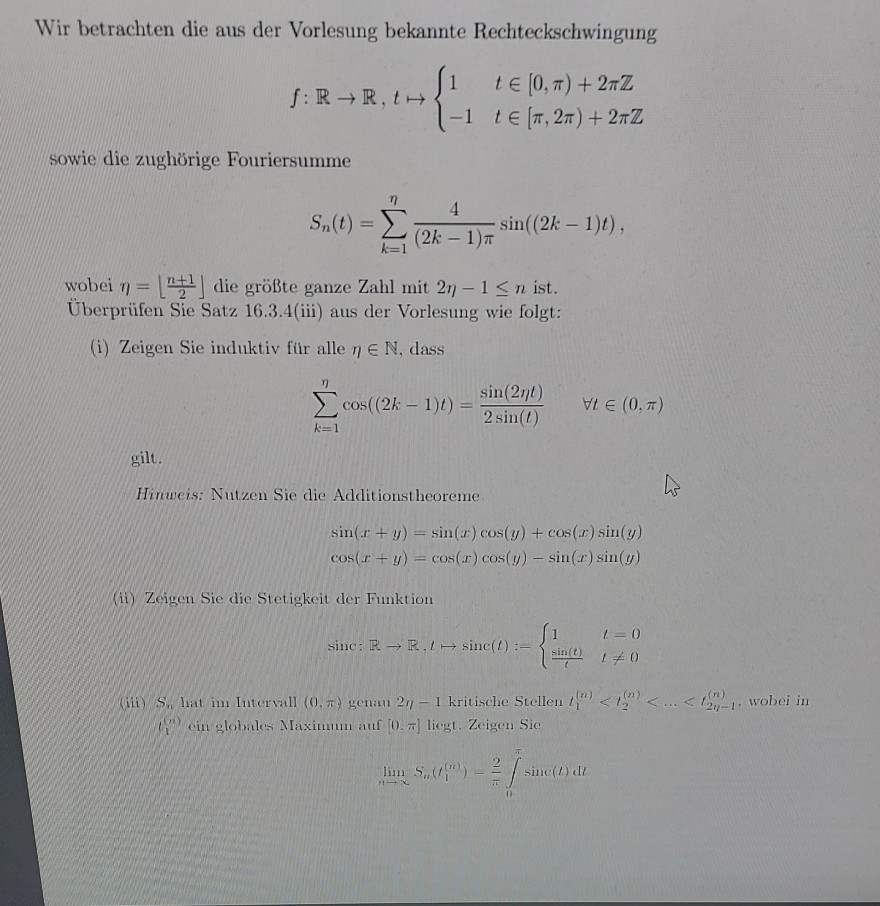Aufgabe:

Text erkannt:
Wir betrachten die aus der Vorlesung bekannte Rechteckschwingung
\( f: \mathbb{R} \rightarrow \mathbb{R}, t \mapsto\left\{\begin{array}{ll} 1 & t \in[0, \pi)+2 \pi \mathbb{Z} \\ -1 & t \in[\pi, 2 \pi)+2 \pi \mathbb{Z} \end{array}\right. \)
sowie die zughörige Fouriersumme
\( S_{n}(t)=\sum \limits_{k=1}^{\eta} \frac{4}{(2 k-1) \pi} \sin ((2 k-1) t), \)
wobei \( \eta=\left\lfloor\frac{n+1}{2}\right\rfloor \) die größte ganze Zahl mit \( 2 \eta-1 \leq n \) ist. Überprüfen Sie Satz 16.3.4(iii) aus der Vorlesung wie folgt:
(i) Zeigen Sie induktiv für alle \( \eta \in \mathbb{N} \), dass
\( \sum \limits_{k=1}^{\eta} \cos ((2 k-1) t)=\frac{\sin (2 \eta t)}{2 \sin (t)} \quad \forall t \in(0, \pi) \)
gilt.
Hinweis: Nutzen Sie die Additionstheoreme
\( \begin{array}{l} \sin (x+y)=\sin (x) \cos (y)+\cos (x) \sin (y) \\ \cos (x+y)=\cos (x) \cos (y)-\sin (x) \sin (y) \end{array} \)
(ii) Zeigen Sie die Stetigkeit der Funktion
\( \text { sinc: } \mathbb{R} \rightarrow \mathbb{R}, t \mapsto \operatorname{sinc}(t):-\left\{\begin{array}{ll} 1 & 1=0 \\ \frac{\sin (t)}{t} & 1 \neq 0 \end{array}\right. \)
(iii) \( S_{n} \) hat im Intervall \( (0, \pi) \) genan \( 2 \eta-1 \) kritische Stellen \( t_{1}^{(n)}<t_{2}^{(n)}<\ldots<t_{2 \eta-1}^{(n)} \). wobei in (i.) ein globales Maximum auf [0. \( \pi \) ] liegt. Zeigen Sie
\( \lim \limits_{n \rightarrow \infty} S_{n}\left(t_{1}^{(n)}\right)-\frac{2}{\pi} \int \limits_{n}^{\pi} \operatorname{sinc}(t) d t \)
Problem/Ansatz:
Wie löst man die iii.)?
Muss ich die Fouriersumme zweimal ableiten und dann in t t1 einsetzen? In der Fouriersumme ist nichtmal ein n dabei also wie kann ich den Grenzwert von n gegen unendlich bilden?
